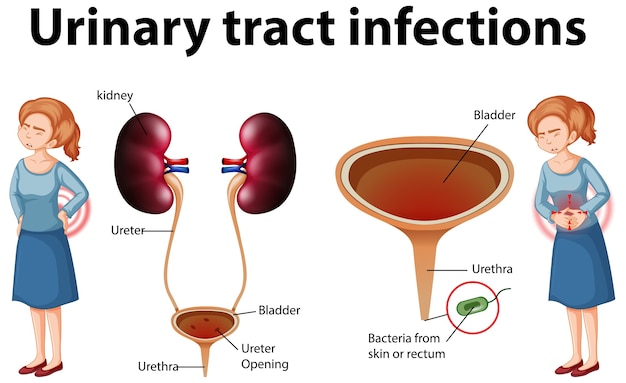
Urinary tract infections, commonly known as UTIs, are among the most frequent bacterial infections affecting people of all ages. These infections can cause significant discomfort and, if left untreated, may lead to more serious complications.
What is a Urinary Tract Infection?
A UTI occurs when bacteria enter the urinary system and cause infection in any part of the urinary tract, which includes the kidneys, ureters, bladder, and urethra. Most UTIs involve the lower urinary tract, particularly the bladder and urethra, though infections can sometimes travel upward, leading to kidney infections, which are more serious.
Pathophysiology of UTIs
The pathophysiology of a UTI begins when pathogens, usually bacteria, enter the urinary tract. While the urinary tract has natural defenses that prevent bacterial growth and colonization, certain factors can compromise these defenses. Once bacteria gain access, they can multiply and adhere to the walls of the bladder or urethra, causing an immune response. This immune activation is what triggers the symptoms of a UTI, such as pain, inflammation, and an urgent need to urinate.
Common Pathogens Causing UTIs
The majority of UTIs are caused by bacteria, although some viral and fungal pathogens can also be responsible. The most common bacterial culprits include:
- Escherichia coli (E. coli): This bacterium is responsible for 70-90% of UTIs. E. coli is normally present in the digestive tract but can enter the urinary tract, especially when hygiene is compromised.
- Staphylococcus saprophyticus: This is a common cause of UTIs in sexually active women and accounts for 5-15% of cases.
- Klebsiella, Proteus, and Enterococcus species: These bacteria are less common but may lead to UTIs, especially in patients with compromised immune systems or those with catheters or other instruments inserted into the urinary tract.
Common Causes and Risk Factors
Several factors increase the likelihood of developing a UTI:
- Female Anatomy: Women are more susceptible to UTIs because they have a shorter urethra, allowing bacteria easier access to the bladder.
- Menopause: Reduced estrogen levels during menopause can affect the protective mucous lining of the urinary tract, making it easier for bacteria to invade.
- Urinary Tract Abnormalities: Structural abnormalities, such as kidney stones or urinary retention, can increase the risk of bacterial growth.
- Use of Catheters: Catheterized patients have a higher risk of UTIs because catheters bypass natural defenses, providing direct entry for pathogens.
- Immune System Suppression: Conditions like diabetes or medications that suppress immune function can make individuals more susceptible to infections, including UTIs.
Preventive Measures for UTIs
Prevention is key in managing the risk of UTIs, and the following habits can help reduce your likelihood of infection:
- Hydration: Drinking plenty of water helps flush bacteria from the urinary tract, reducing the risk of infection.
- Urinate Regularly: Avoid holding urine for extended periods. Regularly emptying the bladder helps clear bacteria that may enter the urinary tract.
- Avoid Irritants: Certain products, like harsh soaps, douches, and feminine sprays, can irritate the urinary tract and increase infection risk.
Homeopathic Remedies for UTIs
- Cantharis: Known for helping with severe burning and pain during urination, Cantharis is often recommended for UTIs accompanied by intense discomfort and frequent urges to urinate.
- Staphysagria: This remedy is commonly used when UTIs are triggered by emotional stress or recent sexual activity. It may relieve the sensation of irritation and burning.
- Pulsatilla: When symptoms are mild but accompanied by increased urination and discomfort, especially in individuals who are sensitive and emotional, Pulsatilla can be helpful.
- Sarsaparilla: Useful for sharp, intense pain toward the end of urination, Sarsaparilla is often recommended for UTIs with a frequent urge to urinate but difficulty passing urine.
Additional Homeopathic Remedies
- Apis Mellifica: Recommended for women experiencing a burning or stinging sensation and swelling in the urinary tract, Apis is often chosen when there is a sensation of fullness in the bladder with minimal output.
- Nux Vomica: This remedy is useful for individuals experiencing frequent, ineffective urges to urinate, often coupled with abdominal cramping or bloating.
- Berberis Vulgaris: Known for relieving sharp, shooting pains in the urinary tract, especially in the bladder and kidney area, Berberis is beneficial for UTIs with discomfort extending to the thighs or lower back.
- Equisetum: Often used for a dull, aching sensation in the bladder and frequent urination, Equisetum is recommended for those experiencing fullness and irritation, even after emptying the bladder.
- Aconitum Napellus: This is useful for sudden-onset symptoms, particularly after exposure to cold weather, with burning and agitation during urination.
If there is history of recurrent urinary tract infections then the root cause needs to be looked into BOOK A CONSULT
